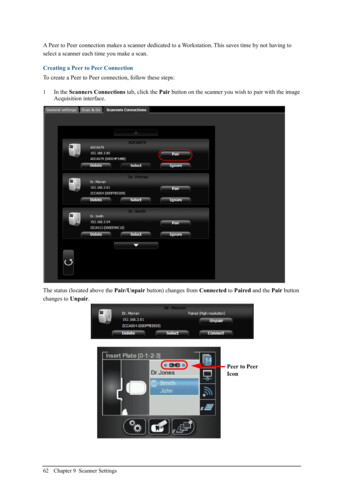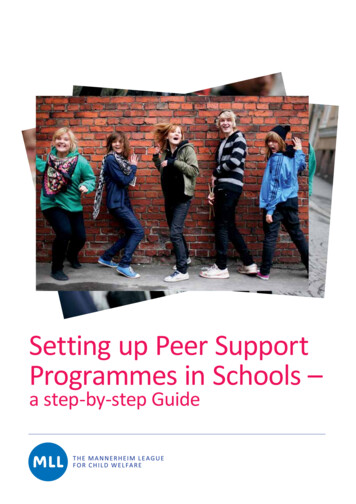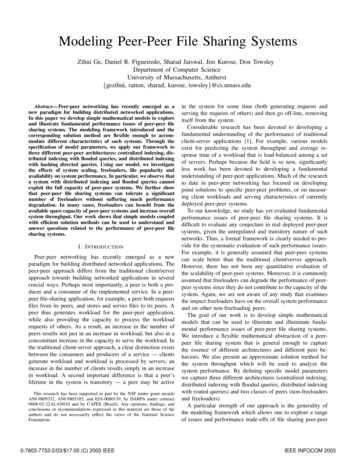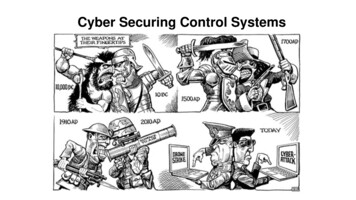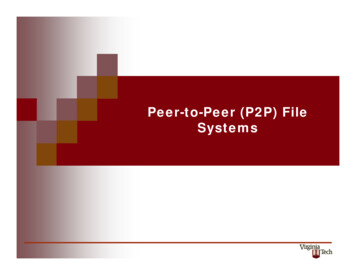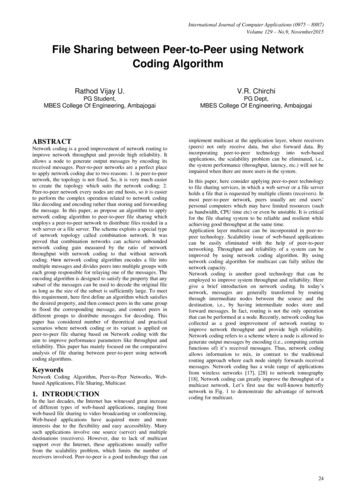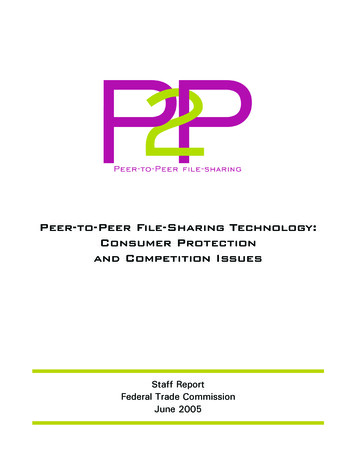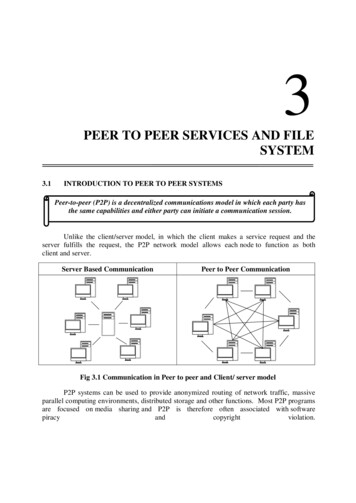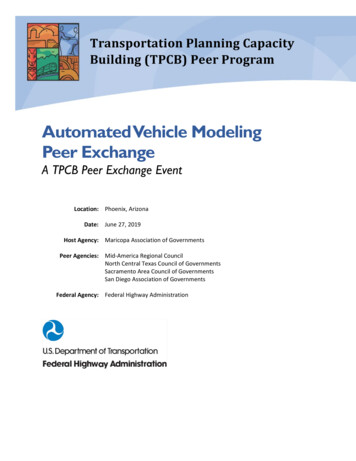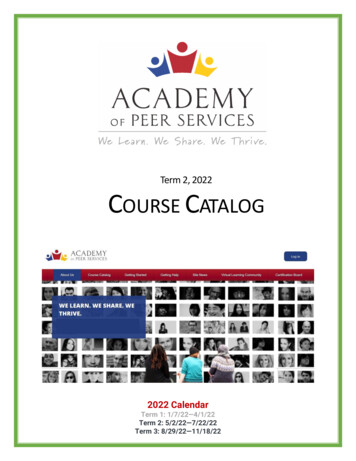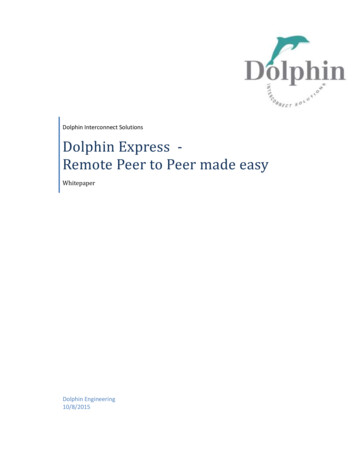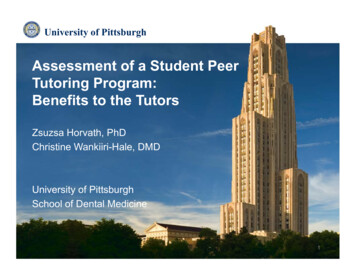
Transcription
University of PittsburghAssessment of a Student PeerTutoring Program:Benefits to the TutorsZsuzsa Horvath, PhDChristine Wankiiri-Hale, DMDUniversity of PittsburghSchool of Dental Medicine1
Objectives Identify benefits of a peer tutoringprogram for the tutors. Identify elements of multi-prongedassessment of a peer tutoring program Identify the use of assessment topromote a school culture in whichstudents seek, accept and offerassistance
Benefits of Peer Tutoring: Tutee assisting struggling and distressed studentsimproving grades & academic achievementincrease student success & graduation ratesmore comfortable learning environmentlessons better suited to the level of the tuteesemotional benefits of interaction with moresenior students tutoring mentoring
Benefits of Peer Tutoring: Tutor reviewing & revisiting course materialdeveloping teaching skillsincreased understanding of a topic?
Types of Tutoring Programs for academic credit or paid group setting or one-on-one sessions responding to failure or targeted tostruggling students
Program Development Office of Student Affairs– Support Student Academic success– Multiple student requests for academicsupport University of Pittsburgh AcademicResource Center (ARC)– Undergraduate peer tutoring– Adapted structure and training materials
Collaboration and Buy-In Collaborated with Office of AcademicAffairs, Student Promotion Committee,Curriculum Committee, and CourseDirectors to:– Identify courses for tutoring– Develop elective course & syllabi (credit)– Identify of tutors– CODA
Course Development Student Peer Tutoring Program (est. Fall2015)– Intro. to Peer Tutoring in Dental Education (2cr.)– Peer Tutoring in Dental Education (1cr.)– Developed Blackboard course site– Tutors identified and enrolled (D2-D4)– Tutees Identified (D1 & D2) open to all students after initial pilot term
Session: Do’s & Don’ts of Peer TutoringObjectives: Accept the role of a peer-tutor Appreciate & understand the academic & ethical guidelinesof peer-tutoring
Session: Interacting in a TutoringSession – Objectives Identify principles of learning relevant topeer tutoring Identify effective teaching techniques forone-on-one and small group peertutoring sessions. Recognize the steps to create tutoringmaterials in Course/Web/Blackboard
Session: Interacting in a TutoringSessionOne-on-OneGroupLabDiagnose: study skills reading skills note takingskills
Resources From McGuire's Teach Students How to Learn. p. 179 http://www.odu.edu/educ/llschult/blooms taxonomy.htm McGuire's Teach Students How to Learn Online Resources
Implementation New Student TrackingOrientation End of Term Review Program Solicitation Post-Term Survey Tutor Matching
Implementation Additional Tutoring Opportunities– Quiz/Test Banks– Exam Review Sessions– Help Desk Sessions– Finals Study Breaks
Program Assessment: MethodsTutors Pre- and post-course surveys– expectations, prior experience, perceived preparedness– standard course evaluation and student feedback– perceived gain in skills & perceived change in preparedness– teaching experience and perceptions about tutoring Reflective journals– what went well, what challenges they had, and what theywould do differently next timeTutees Post course surveys
Program Assessment: Methods Time frame: Fall 2015 – Summer 2017 First time tutors: 73 Veteran tutors: 60 Tutees: 234 Tutees in study: 106
Results: TuteesTutee Feedback (N 106)CategoryPercentage of tuteesAgree or strongly agree working with their tutorimproved their grade in the course76%Agree or strongly agree the tutor helped themunderstand course material better82%Agree or strongly agree their tutor providedeffective tutoring sessions88%
Results: First Time TutorsPreparedness of First-Time Tutors(Pre-course N 75, Post-Course N 78)70%62%56%60%Percentage50%40%Post-course1% 0%1% 1%35%30%20%Pre-course24%15%10%3%0%Very preparedSomewhatpreparedNot SureSlightlySubstantiallyunderprepared underprepared
Results: First Time TutorsTutor Concerns About Tutoring(Pre-Course N 69, Post-Course N 68)Percentage of Tutors35%30%30%29%15%Pre-coursePost Course25%20%28%20%15%18%13%10%5%0%0%Lack of knowledgePersonalCourseworkIneffective teachingCategorized Concerns about TutoringLack of sessions
Results: First Time Tutors Reflective journal after completion of the tutoring course– what went well– what the challenges were– what they would do differently next timeCategorized ResponsesHad a positive experienceWants to tutor againImproved teaching skillsImproved own skillsReview of materialInterest in teaching as a careerDeveloped a sense of communityPercentage of First timeTutors55%32%25%20%10%4%1%
Limitations Due to the nature of anonymous surveys,there are several aspects that cannot betracked or measured– Cannot track who the students are and who might be changing theiropinions and perceptions Discrepancies in interpretation when coding Low n values, statistical significance may notbe possible at this point Not generalizable
Changes to the Program Asynchronous & synchronous virtual communication Suggestions from previous tutors (excerpts fromjournals) Suggestions for upcoming curricular change Suggestion licensure exam preparation Midterm tracking/check in Quiz/Test Banks Exam Review Sessions Help Desk Sessions Finals Study Breaks Lab tutoring
Conclusions Benefits to tutees Benefit to tutors– academic credit– training– reviewing the course materials– practicing skills for future career– academic and person benefits Tutoring– more accepted– supportive environment
Co-Authors @ University of Pittsburgh Cara Maloney, BS– Dental Student Class of 2021– School of Dental Medicine Nicholas Seger– Undergraduate Student Zachary W. Davis, MS– Academic & Student Support Services Administrator– School of Dental Medicine
Develop or assess your tutoringprogram Sit together in groups– A: have no existing tutoring program &developing a tutoring program– B: already have a tutoring program
Develop or assess your owntutoring program
Q&A
References1. Batz, Z., et al. Helping Struggling Students in Introductory Biology: A Peer-TutoringApproach That Improves Performance, Perception, and Retention. Cell BiologyEducation 2016;14 (2).2. Bene K, Bergus G. When Learners Become Teachers: A Review of Peer Teachingin Medical Student Education. Fam Med 2014; 46(10):783-7.3. Font McCann AL, Lacy ES, Miller BH. Underrepresented Minority Students’Experiences at Baylor College of Dentistry: Perceptions of Cultural Climate andReason for Choosing to Attend. Journal of Dental Education 2014; 78(3): 411-22.4. Fontaine K. Effects of a Retention Intervention Program for Associate DegreeNursing Students. Nursing Education Perspectives 2014; 35(2): 95-99.5. Gottlieb Z, Epstein S, Richards J. Near-peer Teaching Programme for MedicalStudents. The Clinical Teacher 2016; 14(3): 164-69.6. Hum L, Maccaro J, Park SE. Cross-Year Peer Tutoring in Healthcare and DentalEducation: A Review of the Literature. Journal of Curriculum and Teaching 2014;3(2): 43-57.7. Iwata K, Furmedge DS. Are All Peer Tutors and Their Tutoring Really Effective?Consider Quality Assurance. Medical Education 2016; 50(4): 393-95.8. Olivares-Ureta M, Williamson JW. Pre-Admission Factos and Utilization of TutoringServices in Health Professions Educational Programs. Journal of Allied Health2013; 42(2): 74-78.
Thank you!Zsuzsa Horvathzshst2@pitt.eduChristine Wankiiri-Halechwst11@pitt.edu
Christine Wankiiri-Hale, D.M.D.Zsuzsa Horvath, Ph.D.University of PittsburghSchool of Dental Medicine2018 Assessment InstituteMonday, October 22Assessment of a Student Peer Tutoring Program: Benefits to the TutorsDevelop or Assess your Tutoring ProgramDevelop your Tutoring Program – What do you need?1. List the resources on your campus that you can use (consult, tap into, etc.)2. List any existing support infrastructure that can be helpful to your program development3. Identify the courses in your curriculum in which students would most benefit from a tutoringprogram4. Consider pros and cons of peer or professional tutors and which model would be the mostbeneficial and feasible for your setting5. Consider what you can offer for tutors as incentive (payment, academic credit, etc.)6. Consider how you would secure faculty buy-in and who the stakeholders are at your school(course directors, curriculum committee, promotions committee, office of education/academicaffairs, etc.)7. Consider who the support personnel will be (overseeing and administering the program, trainingtutors)8. Consider your capacity for enrollment for tutors9. Consider your capacity for enrollment for tutees10. Consider your process for tutor selection (data from admissions, promotions, academic affairs,student affairs; recommendation by course director; self-selection, etc.)11. Consider your process for tutee selection (data from admissions, promotions, academic affairs,student affairs; recommendation by course director; self-selection, etc.)12. Consider components for program assessment (tutee success, tutor success, training materials,faculty feedback, etc.)13. Consider anticipated challenges
Revising/Assessing – What works well, what are the challenges?1. List the resources on your campus that you use (consult, tap into, etc.)a. Are you using all resources available?b. Are these resource efficient?2. List any existing support infrastructure that are helpful to your program developmenta. Is the support infrastructure sufficient for your needs?3. Identify the courses in your curriculum in which students would most benefit from a tutoringprograma. Do you provide tutoring in the courses in which students are struggling the most?b. Do students struggle in any areas outside of the currently available courses for tutoring?4. Consider pros and cons of peer or professional tutors and which model would be the mostbeneficial and feasible for your settinga. Does your model work for you?b. Do you have any reason to switch to another model?5. Consider what you offer for tutors as incentive (payment, academic credit, etc.)a. Does your incentive structure work for you, for your tutors and tutees?6. Consider how you would secure faculty buy-in and who the stakeholders are at your school(course directors, curriculum committee, promotions committee, office of education/academicaffairs, etc.)a. Do any of your stakeholders need to be updated on the tutoring program?7. Consider who the support personnel are (overseeing and administering the program, trainingtutors)a. Do you have sufficient support personnel for your tutoring program?8. Consider your capacity for enrollment for tutorsa. Can you manage the number of tutors you have?b. Do you have a sufficient number of tutors?c. Do you need to increase or decrease the number of tutors? If so, how can you do that?What do you need for that?9. Consider your capacity for enrollment for tuteesa. Do you have capacity to take more tutees?b. Do you have the need to offer more opportunities for tutoring?c. Do most students who would benefit from tutoring enroll in the program?10. Consider your process for tutor selectiona. Are you using data from admissions, promotions, academic affairs, student affairs;recommendation by course director; self-selection?11. Consider your process for tutee selectiona. Are you using data from admissions, promotions, academic affairs, student affairs;recommendation by course director; self-selection, etc.?12. Consider your components for program assessment (tutee success, tutor success, trainingmaterials, faculty feedback, etc.)a. How do you currently assess your program?b. Are there any missing components in your assessment?c. Have you made any changes to your tutoring program?13. Consider past and anticipated challengesa. What are the challenges you have faced and resolved recently?b. Do you have any unresolved challenges?c. Are you anticipating any new challenges?
School of Dental Medicine 2018 Assessment Institute Monday, October 22 Assessment of a Student Peer Tutoring Program: Benefits to the Tutors Develop or Assess your Tutoring Program Develop your Tutoring Program - What do you need? 1. List the resources on your campus that you can use (consult, tap into, etc.) 2.
